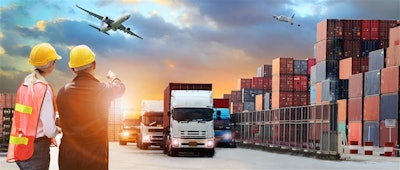
Did the pandemic “cause” the supply chain issues we are experiencing, or merely exacerbate existing weaknesses and issues? Whether it's the new furniture for the office, the part for your automobile or the fancy coffee you are giving your sister for Christmas that is brought in by a distributor, goods coming from outside the country will have to traverse through a complex system of infrastructure constraints and government organizations, in addition to the complexities the commercial supply chains have, themselves. As has been highlighted by recent supply chain disruptions, one step out of line can disrupt the whole system—and many steps are out of line before your shipment leaves its origin.
Whereas many think of the supply chain issues as pertaining to containerized cargo only, the reality is that the issues are systemic, and indeed likely endemic to all modes of transport and commerce. Pre-pandemic, our measure of efficiency was basically getting what we ordered in the timeframe expected, at a predictable price. The pandemic has certainly added unique challenges, but multi-lateral and bi-lateral trade challenges, increased pressures for on-demand ordering and aging infrastructure were all issues prior to the pandemic.
Today, the traditional movements and established choreographies have proven to be deficient in times of great disruption(s). Pent-up consumer demand during lockdowns soon overwhelmed global supply chains hit by capacity constraints. Goods scheduled for travel in containers have been subject to container shortages, but also to limitations in the infrastructure to off-load, transfer and inspect. Additionally, the labor shortage created a host of other problems. According to data from RBC Capital Markets, two of the biggest U.S. ports saw a 30% increase in the amount of goods going through them while processing the cargo with 28% less workers. In July, the U.S. Department of Labor reported that the warehouse industry had a record 490,000 job openings. Meanwhile, the trucking industry has a shortage of over 80,000 drivers. With fewer workers to process shipping containers for example, it creates mounting problems such as empty containers remaining in yards and warehouses with no room to process new ones filled with goods, and no way to remove the empty ones.
Despite government agencies continuing to work during the pandemic, port closures, staffing limitations and a need for more robust risk management capabilities all placed additional stress on an already fragile system. The present conflict in Ukraine, secondarily to the violence and hardships being experienced by the Ukrainians, is also having an impact on global trade and supply chains.
While much is made of how companies can navigate supply chain problems, there is also a significant role for government agencies to play in mitigating the ongoing supply chain crises.
Where can governments improve?
How can government agencies, many of which have their own challenges with staffing and volume, step into the breach and make life easier for the private sector?
Among the most immediate “knock-on” effects of the current supply chain crises, in the U.S. a significant number of customs officers are funded through the collection of fees. With the combined effects of the COVID-19 crisis upon global trade and the myriad supply chain issues, the amount of fees collected dropped significantly (although fee collection will increase again as throughput improves), impacting government’s ability to pay for all the resources it needs. Increasing throughput, therefore, is a problem that is in the interests of government and the private sector to solve.
The first way is through improved transparency and coordination. Maintaining the predictability that we have come to expect, and the precision we strive for, from supply chains requires a high degree of coordination not only between supply chain partners as well as public and private sectors, but inter- & intra-governmental coordination as well.
Transparency of the current state of broader supply chain issues may be easier for commercial entities to achieve and will help global supply chain operators and logistics managers plan for contingencies more effectively. Government agencies can certainly contribute to increasing transparency, but have less flexibility given the nature of their overall operations and multi-agency dimensions—an area for improvement. An increase of transparency and communication can go so far as aiding in building in greater flexibility in terms of import / export / transit declarations for cargo that is redirected during an emergency, which can help ease supply chain bottlenecks. This would improve how government agencies and businesses can navigate the current challenges and build a longer-term framework for a more tech-enabled supply chain where agencies and businesses can better anticipate and manage potential bottlenecks. In an effort to improve transparency, The White House has recently launched a supply chain dashboard that provides live updates in an effort to create “greater coordination between our closest trading partners to overcome these collective issues.” This is an exercise that may also prove useful for state and municipal authorities.
The second way is through improved technology. Even beyond the current challenges, tech and data advancements such as digitization, enhanced fraud detection, and port movement optimization would make a meaningful difference in the long-term. Technologies such as data analytics, blockchain and high-speed screening have a large part to play in spotting and addressing risks, tracking goods (and components) from origin to end user, and reducing the need for manual inspections. Increased automation of clearance processes will also cut costs and clearance times, benefiting sellers and consumers. Mexico for example, has rolled out technology to automatically read license plates as they reach the border terminal so data can be collected and analyzed on the vehicle ahead of time, creating a larger evaluation time-window and creating more efficiency for shipment vehicles coming across its borders.
The third way is through improved international collaboration. Multilateral problems require multilateral solutions. In a sign of things moving in the right direction, the U.S. is currently reviewing and moderating all international trade statutes, regulations, and policies. The country’s new 21st Century Customs Framework (21CCF) combines an updated legal framework with exciting new technologies.
In addition to the U.S.’s changes, international organizations such as the World Trade Organization (WTO) are encouraging adoption of common standards like the Trade Facilitation Agreement, which includes provisions for electronic logging of documentation, certification, payment of duties and fees, as well as use of “single windows” and increased intra-agency and international data sharing. In eCommerce, for example, data sharing between customs, border, tax and other authorities from both the origination and destination countries, as well as between the authorities and eCommerce platform owners, will create more transparency, improve compliance and reduce costs throughout the entire process.
Better communication creates better plans
Underpinning all these areas for improvement is the need for better communication, to include new or additional data that may be required by governments. The more that governments communicate with other governments as well as the private sector, the more logistics planning will improve, and the opportunity for improved risk assessment by governments. Thus, benefits to the private sector and governments.
This creates opportunities for better contingency plans and provides answers to essential questions like “How can we better prepare for future disruptions?” and “How can we avoid issues that contributed to today’s challenges in global supply chains?” With better information and communications, companies and governments can take contingency planning and emergency preparedness to new levels.
With both private sector companies and their customers stressing about the difficulties of the current state of our global supply chain, governments have a chance to step in and provide some relief. Through greater transparency, improved technology, stronger international coordination, and effective inter-agency communication, a better world is possible.













![Pros To Know 2026 [color]](https://img.sdcexec.com/mindful/acbm/workspaces/default/uploads/2025/08/prostoknow-2026-color.mduFvhpgMk.png?ar=16%3A9&auto=format%2Ccompress&bg=fff&fill-color=fff&fit=fill&h=135&q=70&w=240)




